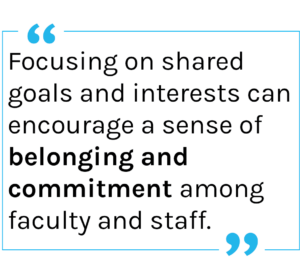Professional development is a huge factor in retention, but getting faculty and staff to engage with professional learning can be tough.
Creating professional development learning communities (PLCs) within higher education institutions can lead to increased employee engagement, improved retention, enhanced collaboration, and personalized learning. Below, check out a few strategies to help your institution create effective PLCs that faculty and staff are eager to be a part of:
Build Strong Relationships and Encourage Reflective Practices
PLCs are designed to build stronger relationships between team members through regular meetings and a shared commitment to student learning. These communities encourage reflection on instructional practices and student progress, which can lead to a more cohesive and collaborative environment.
Establish Clear Communication and Social Presence
Effective communication is the backbone of any community. In an online setting, it’s crucial to create a plan for communication that includes real-time meetings and opportunities for information and expertise sharing. This helps in establishing a social presence and a sense of belonging among members.
Engage Through Shared Goals and Interests
Research suggests that participation in learning communities is more related to student engagement than to educational outcomes.  Therefore, focusing on shared goals and interests can encourage a sense of belonging and commitment among faculty and staff, which is essential for retention and engagement.
Therefore, focusing on shared goals and interests can encourage a sense of belonging and commitment among faculty and staff, which is essential for retention and engagement.
Emphasize Collaborative Learning and Professional Growth
Learning communities should emphasize collaborative partnerships between students, faculty, and staff. They provide opportunities for professional growth outside the classroom in a supportive and non-judgmental environment, which can lead to improved teacher satisfaction and lower turnover rates.
Utilize Collaborative Learning Techniques
Incorporate collaborative learning techniques to allow members to share ideas and work on common professional issues. This not only enhances the learning experience but also encourages members to become more invested in their work and the community.
Support Continuous Improvement
PLCs should provide continual improvement opportunities, encouraging ongoing professional development rather than one-time-learning. Continuing growth and learning is crucial for keeping faculty and staff engaged and up-to-date with the latest educational practices.
Prioritize Personalized Learning
Personalized learning within PLCs can cater to the individual needs and interests of faculty and staff, making the community more appealing. By allowing members to pursue their unique professional development paths, PLCs can enhance individual engagement and contribute to the overall success of the community.
Conclusion
Building learning communities that faculty and staff want to join requires a strategic approach that focuses on fostering strong relationships, clear communication, shared goals, collaborative learning, and continuous improvement. By creating an environment that values professional growth and personalized learning, institutions can ensure that their PLCs are engaging and beneficial for all members. If you’re interested in a tool that supports engaged professional development and learning at your institution, check out PeopleAdmin’s software or reach out to our team.